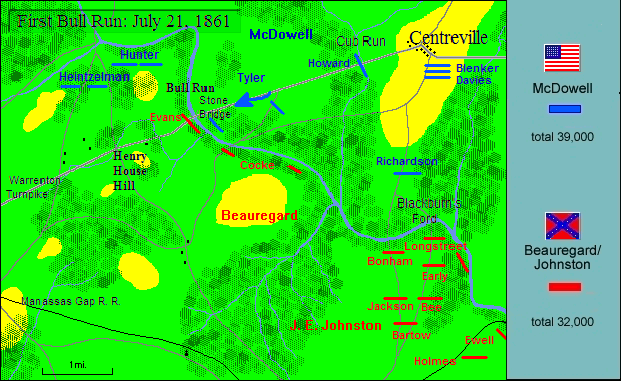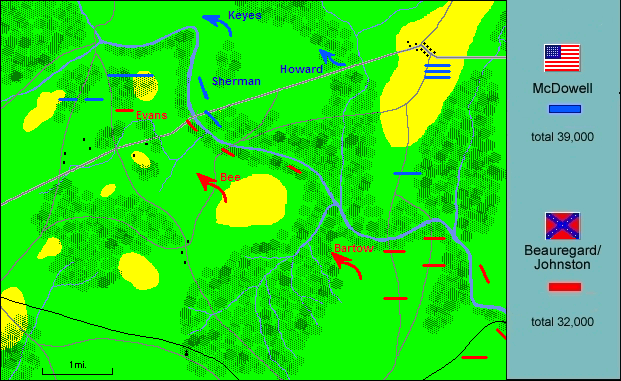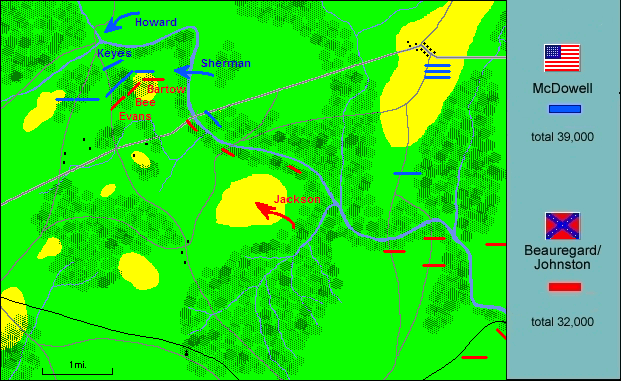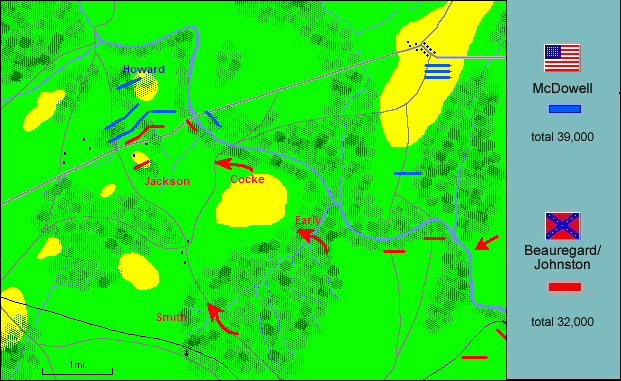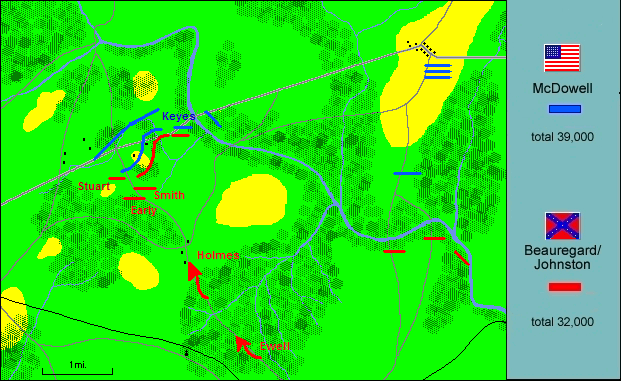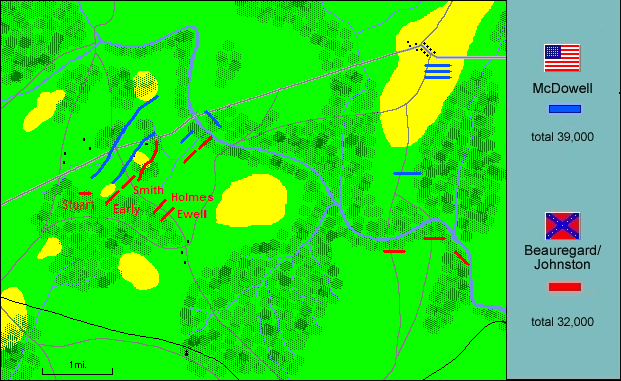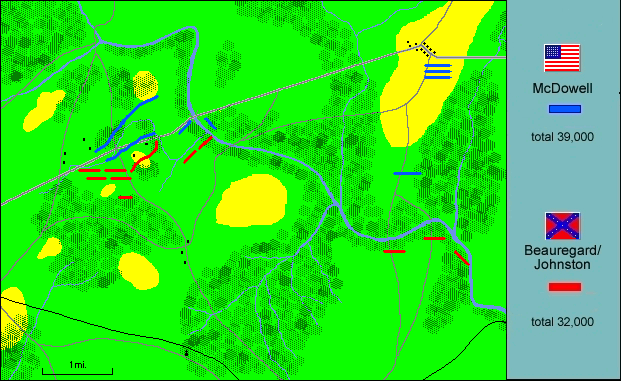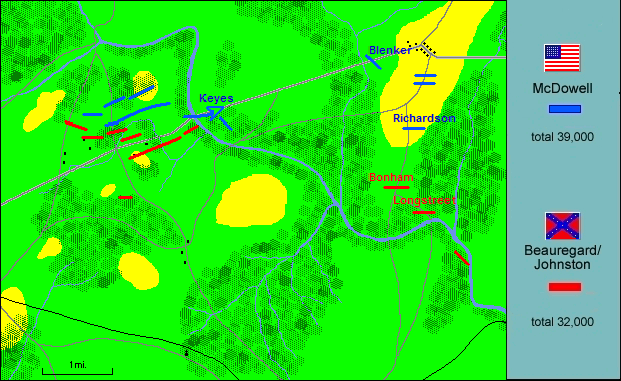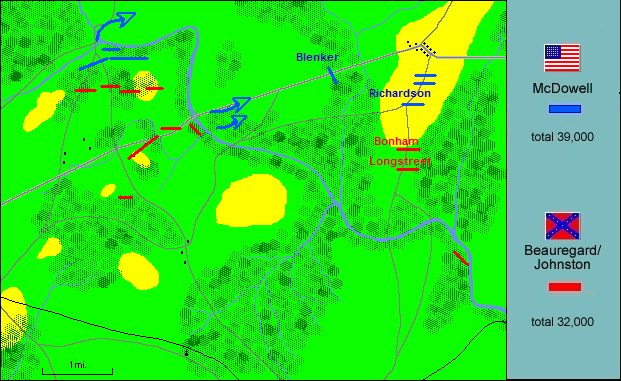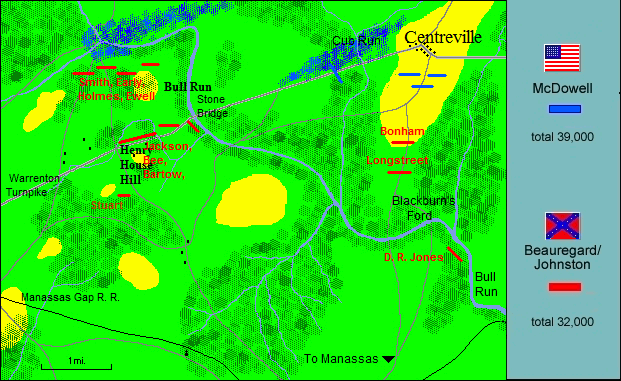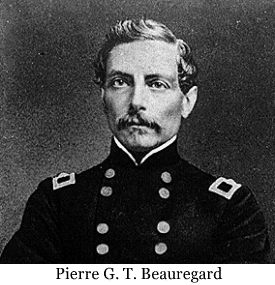
But McDowell, despite delay and confusion, got off first. At two a.m. on July 21 the Union commander roused his sleeping army. The attacking column made a six-mile march through the dark underbrush, and by 9:30 most of David Hunter’s Second and Samuel P. Heintzelman’s Third Division were across Bull Run at Sudley Springs–where there were virtually no Confederates to receive them. About seven a.m. Tyler’s division went forward to make its demonstration at the Stone Bridge and one brigade of Colonel D. S. Mile’s division feinted toward Blackburn’s Ford. The demonstration, however, was mainly a slow, steady cannonade that made a good deal of noise but failed to convince anyone that McDowell intended to strike at the bridge. The bridge was defended by a South Carolina West Pointer, Colonel Nathan G. Evans, nicknamed “Shanks” for his spindly legs. In the old army, Evans had earned a reputation as a hard-drinking, hard-driving dragoon. Today he commanded two regiments of infantry, some cavalry, and a few guns in front of the Stone Bridge–where, he believed, nothing important was going to happen. Upstream to his left, the important things were going to happen. One of the few Confederates in the area was a captain of engineers, Edward Porter Alexander, who had been abruptly awakened that morning when one of the first shells of Tyler’s barrage tore through his tent. When Alexander saw the Federal column advancing, he immediately understood the danger to the Confederate left and just as immediately communicated the danger to Evans at the Stone Bridge. Leaving four companies to guard the bridge, Evans hurried to the left with the rest of his command and two cannons, about a thousand men in all. When the lead elements of McDowell’s attacking column (four regiments under the magnificently whiskered Ambrose E. Burnside) finally got moving down the Sudley Road about mid-morning, they found Evans drawn up a little north of the Warrenton Pike, and prepared to contest its passage.
Burnside’s regiments outnumbered the Confederates, but of course it was the first time virtually all of his men had heard a shot fired in anger. They made two uncoordinated and not-very-determined attacks and fell back in disorder, done for the day. But as Burnside’s men withdrew, fresh troops of Colonel Heintzelman’ s division came up and continued to press Evans, whose command was now in danger of falling apart. To Beauregard on Lookout Hill near Mitchell’s Ford, he called for help, but before Beauregard could respond, help reached Evans in the form of Brigadier General Barnard Bee who had come on the run on his own initiative. Bee’s brigade had been in the Valley with Joe Johnston, but had got off the cars at Manassas Junction in time to double-quick up the Sudley Road and confront the Federal advance. McDowell, however, was handling his green army skillfully thus far. From the ford at Sudley Springs, he fed more of his attacking column into the fight against Bee and Evans, maintaining a punishing pressure on the Confederate left. To Tyler at the Stone Bridge, he sent word to try to force a crossing. One of Tyler’s brigades, led by a man who would make a name for himself as a remorseless fighter, Colonel William T. Sherman, got across the river about a half-mile above the bridge and fell in on McDowell’s left. Joined by other regiments of Tyler’s command, Sherman’s troops hammered the Confederates on their front. A little before noon it was the Confederates turn to do some running. They ran southward across the Warrenton Pike, in some disorder but not broken, and formed a new line on the crest of a hill named for a family farm, Henry House Hill. There they were joined by Wade Hampton’s South Carolina command and two regiments under Colonel Francis S. Bartow. On them depended the Confederate left and in all probability the Confederate army.
On Lookout Hill Beauregard and Johnston were trying to read the battle mainly from the racket of musketry and the rising clouds of smoke and dust. Johnston was Beauregard’s senior, but because he had arrived too late to review the terrain and disposition of troops, Beauregard held the field command. Although they were both men of prickly pride, they worked together well this day. First, Beauregard surrendered to an inevitable conclusion; the flank attack he had planned on McDowell’s left was not going to happen and the troops he had intended for it would be urgently needed for a counter-strike on the Union right. Second, and more dramatic, Joe Johnston, listening to the roar from that direction, said simply, “The battle is over there–I am going,” and rode toward Henry House Hill. Beauregard remained briefly to order more troops from his right to his left and hurried himself toward the hill. Before either of them could reach the hill, however, the five regiments of Thomas J. Jackson’s Virginia brigade would be forming up on its crest.
On Henry House Hill McDowell was making the weight of his 10,000 felt, and he had another 8,000 across the Run who had not yet managed to get into the fight. The 6,000 Rebels who pushed back against that weight were in a good deal of trouble. Evans’ command looked to be shot-up and fought-out; Bee’s brigade was slowly and stubbornly collapsing toward the rear. Bartow waved a flag and shouted to his two Georgia regiments, “General Beauregard says you must hold this position–Georgians, I appeal to you to hold on.” A moment later he was killed by a Minie ball. Meanwhile, Beauregard himself had reached the hill and, while trying to firm up his line, was soon unhorsed, but unhurt, by a Federal artillery shell. General Bee rode to the crest of the hill where Jackson stood with his Virginians. “General, they are beating us back,” he said. Jackson, with an icy, almost eerie ferocity he carried into combat, replied, “Sir, we will give them the bayonet.” Bee returned to his brigade and then, just moments from eternity himself, gave Jackson an immortal name. Waving his sword, he called out, “Look! There is Jackson standing like a stone wall! Rally behind the Virginians!” It is a poetic moment worthy of Shakespeare’s Prince Harry at Agincourt, but one dissenting opinion is worth noting. Jackson’s brigade was actually a little behind the crest of the hill. At least one witness in the fog of battle on Henry House Hill understood Bee, seeing Jackson not advancing to his aid, to say, “Look at Jackson standing there like a damned stone wall.” What Bee really meant went to his grave with him, for shortly thereafter a bullet tore through his abdomen and killed him. Still, poetry aside, Jackson’s brigade did stand, and ever after he would be Stonewall Jackson and his brigade the Stonewall Brigade.
But McDowell was not done on Henry House Hill. By the middle of the afternoon he had four brigades in line for another push. Most of these men had been marching and fighting since two o’clock that morning, and by this time they were hot, hungry, thirsty, and tired. When the assault commenced, it went forward in pieces by regiments and never hit with concerted and concentrated force, (nor did it receive any help from the remainder of Tyler’s division that still faced the Stone Bridge). To support the infantry assault, McDowell ordered two batteries of regular artillery forward to a piece of high ground just south of the Henry house. As they went forward, they ran into a sharp fire of musketry from Confederates behind the Henry house, and in their attempt to drive the Rebels off, they sent shells into the house itself. The mistress of the house was Mrs. Judith Henry, a bed-ridden, 84-year old widow. Her sons had taken her once to safety, but she begged to return. If she were to die that day, she wanted to die in her own home. Just as her sons returned her to her bed, a shell killed her instantly. She was older than the Constitution, and no one knew what her political sympathies were, but she was among the casualties of war to be numbered along Bull Run.
Now Federal infantry went forward to support the exposed artillerymen. They were a regiment of gaudy New York Fire Zouaves in scarlet trousers, blue tunics, and white turbans, and a battalion of brand-new Marines (recruits who had been Marines just three weeks). Just as they were forming up, Jeb Stuart came riding in from the Valley with a regiment of calvary. Confusing the Fire Zouaves for a unit of Alabama Zouaves, Stuart rode nearly into them before discovering his mistake, whereupon he immediately charged, driving eastward up the Warrenton Pike and scattering the Yankees wildly to the rear. The Union batteries, now entirely unsupported, were exposed to murderous rifle fire. A Confederate regiment in blue uniforms came forward. (The war was but two months old; some Rebels wore blue and some Federals cadet gray.) When Federal gunners mistakenly held their fire, the Rebels in blue delivered a volley at seventy yards. A Union officer remembered that “it seemed as though every man and horse of that battery just laid down and died right off.”
All along the crest of Henry House Hill Union and Confederate infantry continued hammering away at each other, but Beauregard and Johnston’s men were beginning to feel that the crisis there had passed. From the Confederate right Jubal Early’s brigade arrived and formed on Jackson’s left. Then the last of Joe Johnston’s four Valley brigades, Kirby Smith’s, marched up to form on Early’s left. The Federal attempt to envelop the Confederate left had now definitely failed, and their own right was overlapped and threatened. The Federal spirit to keep up the fight was wilting also, as exhausted men saw fresh troops forming in the enemy’s line while none of their own reserves appeared. About 3:30 they made one more weary lunge at the hill. Jackson instructed his troops, “Hold your fire until they’re on you. Then fire and give them the bayonet. And when you charge, yell like furies!” Down the slope now they came, firing and filling the air with a strange tremulous cry, part fox-hound’s bay and part fox-hunter’s call. It was the first time the Rebel yell was heard on the field of battle. The Federals wavered, faltered, then broke.
It was, at first, a retreat, slow and sullen, the men feeling more betrayed by official incompetence than fairly beaten. “Betrayed! Sold out!” they told each other. They had been in a crucible of fire and smoke, sweat and blood for more than twelve hours; they had endured all they could for one day. Just as telling, their organization was very nearly unraveled. At this point Kirby Smith’s brigade, fresh from the Valley, came forward to press the issue. It was joined by Jubal Early’s brigade, which had done some marching that day but not much fighting yet. With a cheer, they came smashing down on McDowell’s right flank. From that blow onward, it was a confused and chaotic footrace back to the Potomac for the Federals. The rout was on.
McDowell, who had come so close to a handsome victory himself, now made a last, desperate effort to keep defeat from becoming disaster. He got two brigades from his left and a third from his reserve at Alexandria in line near Centreville, hoping to reform and resist the counterattack. But the Confederates could hardly have made a more determined or effective assault on that blue line than the broken pieces of McDowell’s army did. They carried their sweaty panic with them and transmitted it with electric suddenness. Whatever they had been as an organized fighting force an hour before, they were now so many thousands of individual wills bent on a single object: the safety of Washington. The road leading back to Fairfax Court House and Washington was fairly chaotic even before the rout. Thousands of curious civilians–congressmen and their ladies, journalists–had all ridden out to see the rebellion crushed, crowding roads already jammed with ambulances carrying wounded from the field and wagons carrying ammunition to the front. When thousands of soldiers–shouting “We are whipped! Go back! We are whipped!”–washed over them in the dark, the result was a palpably real nightmare. In the road was an English journalist, William Howard Russell of the London Times, who left a vivid description of the scene between Cub Run Bridge and Fairfax Court House: “Infantry soldiers on mules and draft horses with harness clinging to their heels, as much frightened as their riders; Negro servants on their masters’ chargers; ambulances crowded with unwounded soldiers… a shouting, screaming mass of men on foot who were literally yelling with rage at every halt and shrieking out, ‘Here are the cavalry! Will you get on?’… heat, dust, imprecations inconceivable.” Russell stopped one junior officer and asked about the fate of the army. The officer, whose scabbard was empty didn’t really know and, at that point, didn’t much care: “They can stay that like. I know I’m going home. I’ve had enough fighting to last my lifetime.” In the end, at least one thing was clear. While it had taken a full three days for McDowell to get his army down to the banks of Bull Run, what was left of it got back to Washington in 24 hours.
About the same time as the Rebel counterattack got off, the man who had arrived at the critical moment at the critical place, Jackson, was himself a witness to how hot a place it was. A ball went through his coat, another into his horse, and a third snapped a finger of his left hand. Unshaken, he went to the rear to have his wound attended to. There he met Jefferson Davis. Davis, of course, had approached the fight from the rear, from the railroad at Manassas. All old soldiers tell the same tale: approach any fight from the rear, and the victors and the vanquished look more or less alike. Davis in fact, seeing so many fearful Confederate stragglers, thought the day was lost, sure that “fields are not won where men desert the colors as ours are doing.” From horseback near a field hospital he tried to rally the troops: “I am President Davis! Follow me back to the field!” Jackson relieved the anxiety of his commander-in-chief. “We have whipped them!” he shouted, “They ran like sheep! Give me 5,000 fresh men and I will be in Washington City tomorrow!”
It was a bold enough boast, but no more than a boast. For one thing there were no 5,000 fresh troops to be had anywhere; for another, the Confederates were, as Joe Johnston said, more disorganized by their victory than the Federals were by defeat. There was pursuit briefly, some units getting as far as a mile or two beyond Bull Run. A Rebel battery galloped up the Warrenton Pike and unlimbered a gun. As it happened, fierce, old, fire-eating Edmund Ruffin–reputed to have fired that first gun at Sumter–was on hand. The gunners gave him another opportunity to shoot at the “vile Yankee race,” and he sent a shell flying toward Federals running toward Cub Run. But the wreckage of McDowell’s army didn’t require any encouragement. Later, in his battle report, McDowell observed tactfully that “many of the volunteers did not wait for authority to proceed to the Potomac but left on their own decision.” The soldiers simply remembered the long way home as the “Great Skedaddle.”
News of the victory at the Battle of Manassas was the occasion of rapturous joy throughout the South. (Confederates, with a few exceptions, identified battles by their base, usually a town or village; Federals by a landmark at the scene of the fighting, usually a river or stream.) But in the wild rapture was something wildly unrealistic. Many Confederates carried into the conflict the cavalier notion that one true Southron could whip ten Yankee hirelings (or 25 or 100 depending on who was doing the puffing). For those so persuaded, the triumph at Manassas was a self-evident confirmation. It was a point of view that turned a blind eye to the fact that the numbers engaged were virtually equal and that the Yankee hirelings had in truth come within one hard blow of winning the field themselves. Further, the casualty lists might have told Southerners something significant about the Yankee will to fight. McDowell’s army lost about 625 killed and nearly 1,000 wounded; Beauregard’s 400 killed and 1,600 wounded. Except for the 1,200 Yankees captured (most of these lost in the collapse on their right), losses were fairly even. But triumph is an intoxicating brew. Edmund Ruffin thought the battle “virtually the close of the war.” Beauregard should march immediately on Philadelphia and burn it to the ground. Georgia politician Thomas R. R. Cobb was convinced that Manassas was “one of the decisive battles of the world.” Southern independence was secure. Mary Chesnut, however, was among the few Southerners to take a sterner look at their victory. This battle, she confided to her diary, “lulls us into a fool’s paradise of conceit,” while “it will wake every inch of [the enemy’s] manhood.”
There is no question that Northern manhood and morale had been badly shaken by Bull Run. Horace Greeley, so instrumental in urging Lincoln on to aggressive action, now wrote the president, “On every brow sits sullen, scorching, black despair… If it is best for the country and for mankind that we make peace with the rebels, and on their own terms, do not shrink even from that.” But, despite Greeley’s despair, Northern spirit was shaken, not broken. One of Greeley’s own Tribune editors wrote that Americans “do not sit despondently after a defeat… Reverses, though stunning at first, by their recoil, stimulate and quicken to unwonted exertion… Let us go to work, then, with a will.” As for Lincoln, he said simply, “The fat is in the fire now.” Then he went to work with a will. In the week following Bull Run, he began to identify immediate strategic goals and signed two bills for the enlistment of a million three-year men. He also sent an order to the mountains of western Virginia where General George B. McClellan had won some minor victories that had been much celebrated by the press and by himself. To McClellan Lincoln wired “come hither without delay.”

